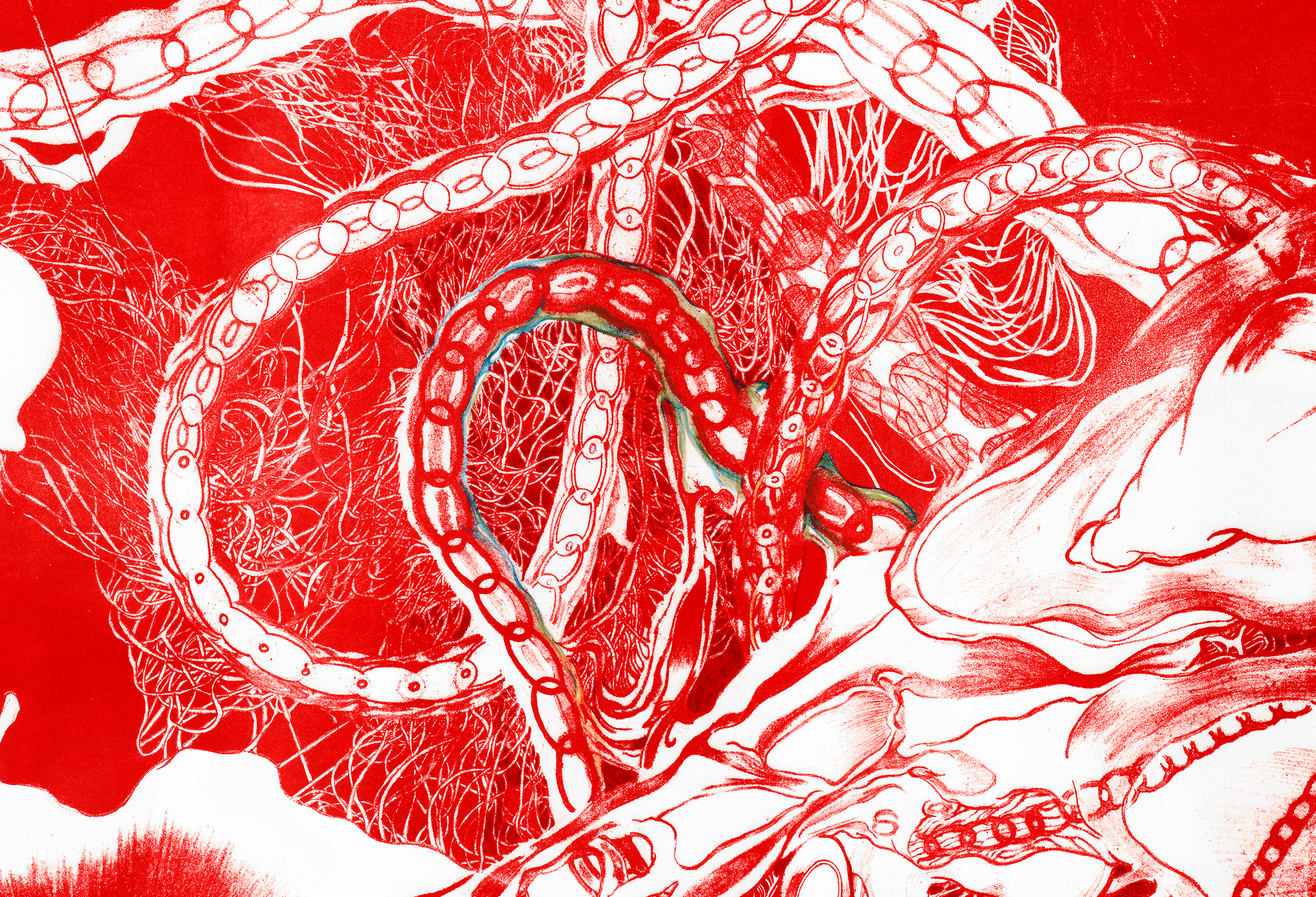The Fifth Child
2020

[ENG]
The Fifth Child (2020), named after Doris Lessing's 1988 novel, is a series of five lithograph prints. Each print depicts a speculative landscape in which an embryo faces the trauma of former generations while they are in their mother's womb. It also visualizes the birth of a character who can bring chaos to current social situations, a bold new identity who can challenge conservative tellings of history.
The Fifth Child (2020), named after Doris Lessing's 1988 novel, is a series of five lithograph prints. Each print depicts a speculative landscape in which an embryo faces the trauma of former generations while they are in their mother's womb. It also visualizes the birth of a character who can bring chaos to current social situations, a bold new identity who can challenge conservative tellings of history.
The Fifth Child (2020) was inspired by my encounters with the cultural landscape of New York in 2019 when I first moved to the city. I observed that historic trauma forms the basis of many collective identities and shapes the city's geopolitical landscape. It made me think of how each individual aligns or builds their values amid the environment of intense interaction.
In Lessing's novel, The Fifth Child, Ben, the dysfunctional fifth child of the family, gives pain to his parents from pregnancy, eventually destroying their conservative fantasies of a perfect traditional family. Reflecting upon the novel and by taking on the role of an outsider, I explore the individual and collective experiences through the eyes of an unborn being, envisioning a speculative scenario of the birth of a character who can bring chaos to current social situations.
Each lithograph depicts the stage of development of an embryo, visualized using botanical and anatomical images:
The Fifth Child 1 shows an image of umbilical cords.
The Fifth Child 2 illustrates the formation of internal organs.
The Fifth Child 3 implies the formation of a fictional character affected by transgenerational trauma by depicting the image of DNA structure.
The Fifth Child 4 visualizes the formation of a fetus's muscle inside the mother's womb.
The Fifth Child 5 illustrates an imaginary being ready to break out of the womb and be born into the unknown world.
The trauma of the former generation is expressed as intense light, inspired by the dramatic use of chiaroscuro in baroque paintings.
[KOR]
다섯 번째 아이 (2020) 연작은 역사적 트라우마가 수많은 집단 정체성의 근간을 이루는 뉴욕의 정치적 상황에서 영감을 받은 작품이다. 뉴욕에 머무는 동안, 나는 인종이나 국적에 따라 나뉘어진 다양한 이익집단들이 그들의 트라우마에 대해 이야기함으로써 도시의 지정학적 지형을 형성하고 있다는 것을 알게 되었다. 나는 이것이 중요한 과거의 상흔이라는 것을 알지만, 이는 종종 다면적인 이해관계에 대한 고려가 결여되어 그 역사에 대한 진정한 이해와 의미 있는 연대를 어렵게 만들기도 한다. 이러한 상황 속에서 나는 수많은 역사의 상처들이 유동적으로 엮여 트라우마에 대한 우리의 반응이 보다 동시대적인 감성 아래에 형성될 수 있는 새로운 공간을 상상하였다.
다섯 번째 아이 (2020) 연작은 역사적 트라우마가 수많은 집단 정체성의 근간을 이루는 뉴욕의 정치적 상황에서 영감을 받은 작품이다. 뉴욕에 머무는 동안, 나는 인종이나 국적에 따라 나뉘어진 다양한 이익집단들이 그들의 트라우마에 대해 이야기함으로써 도시의 지정학적 지형을 형성하고 있다는 것을 알게 되었다. 나는 이것이 중요한 과거의 상흔이라는 것을 알지만, 이는 종종 다면적인 이해관계에 대한 고려가 결여되어 그 역사에 대한 진정한 이해와 의미 있는 연대를 어렵게 만들기도 한다. 이러한 상황 속에서 나는 수많은 역사의 상처들이 유동적으로 엮여 트라우마에 대한 우리의 반응이 보다 동시대적인 감성 아래에 형성될 수 있는 새로운 공간을 상상하였다.
이 새로운 공간은 쓰여지고 재생산되는 역사를 넘어 사람들의 개인적인 경험들이 공감을 통해 진정으로 연대하는 공간이다. 하지만 이러한 공간에 도달하기 위해서는 먼저 보수적인 역사 개념에 도전해야 한다.
5점의 석판화 연작인 다섯 번째 아이는 과학적으로 접근하여 사회적 낙인의 재생산을 방지하겠다는 후성 유전학 연구의 사회적 목표에서 단서를 얻어 배아가 태내에서 자신을 형성할 때에 부모의 정신적 충격에 직면하는 사변적인 풍경을 묘사한다. 이 작품의 제목은 도리스 레싱의 1988년 소설 다섯 번째 아이를 차용하였다. 소설에서 예상치 못하게 얻은 다섯째 아이인 벤은 임신 과정에서부터 부모에게 고통을 주고, 결국엔 자신의 부모가 가진 완벽하고 전통적인 정상 가족에 대한 환상을 짓밟는다. 도리스 레싱의 소설 속 다섯째 아이를 차용해 묘사한 내 작품은 기존의 사회적 가치를 전복시키는 상징으로서의 태아에 초점을 맞춘다. 각 석판화는 총 여섯 개의 에디션으로 구성되어 있는데, 이는 소설 속의 벤 처럼 기본의 사회질서를 파괴하는 전복적인 시기를 지나면 찾아올 새로운 국면을 가져오는 미래의 존재에 대한 기대감을 투영한다.
작업에 사용된 신체적인 이미지는 아무 사회문화적인 정보나 실마리도 제공하지 않아 정치 투쟁의 역사와는 거리가 멀어 보일 수 있다. 하지만 나는 이 작업을 통해 문자 그대로 태생의, 탄생의 공간을 묘사함으로써 이해관계가 얽힌 민족 개념을 초월해 인권을 위한 투쟁의 근간인 인간으로서의 공유된 정체성을 표현하고자 하였다.





















